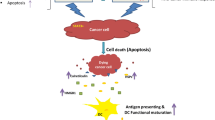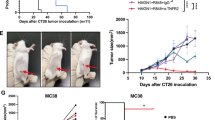Abstract
Background
We have recently reported that chemotherapeutic agents in ultra low noncytotoxic concentrations may block the ability of tumor cells to suppress functional activation of dendritic cells (DCs).
Methods
HCT-116 human colon cancer cells were treated with 0.5 nM paclitaxel (PAC) or 2 nM doxorubicin (DOX) with the aim of defining the immunogenic changes induced by ultra low noncytotoxic concentrations of antineoplastic chemotherapeutic agents. Genetic alterations were screened by DNA microarray that revealed increased expression of genes involved in antigen processing and presentation, including the heat-shock protein, calmodulin, and proteasome 26 genes. As the proteins encoded by these genes are involved in the cytosolic route of antigen processing machinery, we next evaluated whether PAC and DOX in noncytotoxic concentrations changed expression of MHC class I antigen processing machinery (APM) components in three different colon cancer cell lines.
Results
Our results showed that PAC and DOX increased the intracellular expression of APM proteins, including calmodulin, LMP2, LMP7, TAP1 and tapasin. The biological significance of modulation of antigen processing and presentation proteins in tumor cells by ultra low nontoxic concentrations of chemotherapeutic drugs was revealed when non-treated and treated tumor cells were used as a source of tumor antigens for the generation of tumor-specific cytotoxic T cells (CTLs) in vitro. We demonstrated that (i) DCs that engulf tumor cells pretreated with noncytotoxic concentrations of chemotherapeutic agents induced CTLs with a higher cytotoxic potential than DCs loaded with nontreated tumor cells, and (ii) CTLs induced by tumor lysate-pulsed DCs killed live tumor cells more efficiently if these tumor cells were pretreated with noncytotoxic concentrations of chemotherapeutic drugs.
Conclusions
These results demonstrate that chemomodulation of human tumor cells with noncytotoxic concentrations of chemotherapeutic agents increases tumor immunogenicity and results in the generation of more efficient DC vaccines and CTLs, which can be used for cell-based anticancer immunotherapies.


Similar content being viewed by others
References
A.K. Nowak, R.A. Lake, B.W. Robinson, Combined chemoimmunotherapy of solid tumours: improving vaccines? Adv. Drug Deliv. Rev. 58, 975–990 (2006)
C. Menard, F. Martin, L. Apetoh, F. Bouyer, F. Ghiringhelli, Cancer chemotherapy: not only a direct cytotoxic effect, but also an adjuvant for antitumor immunity. Cancer Immunol. Immunother. 57, 1579–1587 (2008)
T. Zhang, D. Herlyn. Combination of active specific immunotherapy or adoptive antibody or lymphocyte immunotherapy with chemotherapy in the treatment of cancer. Cancer Immunol Immunother (2008).
F. Ghiringhelli, N. Larmonier, E. Schmitt et al., CD4 + CD25+ regulatory T cells suppress tumor immunity but are sensitive to cyclophosphamide which allows immunotherapy of established tumors to be curative. Eur. J. Immunol. 34, 336–344 (2004)
D. Hirschhorn-Cymerman, G.A. Rizzuto, T. Merghoub et al., OX40 engagement and chemotherapy combination provides potent antitumor immunity with concomitant regulatory T cell apoptosis. J. Exp. Med. 206, 1103–1116 (2009)
H.J. Ko, Y.J. Kim, Y.S. Kim et al., A combination of chemoimmunotherapies can efficiently break self-tolerance and induce antitumor immunity in a tolerogenic murine tumor model. Cancer Res. 67, 7477–7486 (2007)
S.K. Bunt, L. Yang, P. Sinha, V.K. Clements, J. Leips, S. Ostrand-Rosenberg, Reduced inflammation in the tumor microenvironment delays the accumulation of myeloid-derived suppressor cells and limits tumor progression. Cancer Res. 67, 10019–10026 (2007)
E. Suzuki, V. Kapoor, A.S. Jassar, L.R. Kaiser, S.M. Albelda, Gemcitabine selectively eliminates splenic Gr-1+/CD11b + myeloid suppressor cells in tumor-bearing animals and enhances antitumor immune activity. Clin. Cancer Res. 11, 6713–6721 (2005)
G.V. Shurin, I.L. Tourkova, R. Kaneno, M.R. Shurin, Chemotherapeutic agents in noncytotoxic concentrations increase antigen presentation by dendritic cells via an IL-12-dependent mechanism. J. Immunol. 183, 137–144 (2009)
R. Kaneno, G.V. Shurin, I.L. Tourkova, M.R. Shurin, Chemomodulation of human dendritic cell function by antineoplastic agents in low noncytotoxic concentrations. J. Transl. Med. 7, 58 (2009)
H. Zhong, B. Han, I.L. Tourkova et al., Low-dose paclitaxel prior to intratumoral dendritic cell vaccine modulates intratumoral cytokine network and lung cancer growth. Clin. Cancer Res. 13, 5455–5462 (2007)
M. Obeid, A. Tesniere, F. Ghiringhelli et al., Calreticulin exposure dictates the immunogenicity of cancer cell death. Nat. Med. 13, 54–61 (2007)
T. Panaretakis, N. Joza, N. Modjtahedi et al., The co-translocation of ERp57 and calreticulin determines the immunogenicity of cell death. Cell Death Differ. 15, 1499–1509 (2008)
L. Apetoh, F. Ghiringhelli, A. Tesniere et al., Toll-like receptor 4-dependent contribution of the immune system to anticancer chemotherapy and radiotherapy. Nat. Med. 13, 1050–1059 (2007)
D.R. Green, T. Ferguson, L. Zitvogel, G. Kroemer, Immunogenic and tolerogenic cell death. Nat. Rev. 9, 353–363 (2009)
C.J. Melief, Cancer immunotherapy by dendritic cells. Immunity 29, 372–383 (2008)
G.V. Shurin, I.L. Tourkova, M.R. Shurin, Low-dose chemotherapeutic agents regulate small Rho GTPase activity in dendritic cells. J. Immunother. 31, 491–499 (2008)
I.L. Tourkova, G.V. Shurin, G.S. Chatta et al., Restoration by IL-15 of MHC class I antigen-processing machinery in human dendritic cells inhibited by tumor-derived gangliosides. J. Immunol. 175, 3045–3052 (2005)
T. Ogino, X. Wang, S. Ferrone, Modified flow cytometry and cell-ELISA methodology to detect HLA class I antigen processing machinery components in cytoplasm and endoplasmic reticulum. J. Immunol. Meth. 278, 33–44 (2003)
H. Yu, M. Kortylewski, D. Pardoll, Crosstalk between cancer and immune cells: role of STAT3 in the tumour microenvironment. Nat. Rev. Immunol. 7, 41–51 (2007)
F. Moschella, E. Proietti, I. Capone, F. Belardelli, Combination strategies for enhancing the efficacy of immunotherapy in cancer patients. Ann. NY Acad. Sci. 1194, 169–178 (2010)
P.M. Kloetzel, The proteasome and MHC class I antigen processing. Biochim. Biophys. Acta 1695, 225–233 (2004)
B. Seliger, Molecular mechanisms of MHC class I abnormalities and APM components in human tumors. Cancer Immunol. Immunother. 57, 1719–1726 (2008)
M.G. Brown, J. Driscoll, J.J. Monaco, Structural and serological similarity of MHC-linked LMP and proteasome (multicatalytic proteinase) complexes. Nature 353, 355–357 (1991)
C.K. Martinez, J.J. Monaco, Homology of proteasome subunits to a major histocompatibility complex-linked LMP gene. Nature 353, 664–667 (1991)
V. Cerundolo, A. Kelly, T. Elliott, J. Trowsdale, A. Townsend, Genes encoded in the major histocompatibility complex affecting the generation of peptides for TAP transport. Eur. J. Immunol. 25, 554–562 (1995)
T.H. Hansen, M. Bouvier, MHC class I antigen presentation: learning from viral evasion strategies. Nat. Rev. 9, 503–513 (2009)
G.V. Shurin, I.L. Tourkova, G.S. Chatta et al., Small rho GTPases regulate antigen presentation in dendritic cells. J. Immunol. 174, 3394–3400 (2005)
E. Fonsatti, H.J. Nicolay, L. Sigalotti et al., Functional up-regulation of human leukocyte antigen class I antigens expression by 5-aza-2′-deoxycytidine in cutaneous melanoma: immunotherapeutic implications. Clin. Cancer Res. 13, 3333–3338 (2007)
A.N. Khan, C.J. Gregorie, T.B. Tomasi, Histone deacetylase inhibitors induce TAP, LMP, Tapasin genes and MHC class I antigen presentation by melanoma cells. Cancer Immunol. Immunother. 57, 647–654 (2008)
B. Seliger, U. Ritz, S. Ferrone, Molecular mechanisms of HLA class I antigen abnormalities following viral infection and transformation. Int. J. Cancer 118, 129–138 (2006)
N. Aptsiauri, T. Cabrera, R. Mendez, A. Garcia-Lora, F. Ruiz-Cabello, F. Garrido, Role of altered expression of HLA class I molecules in cancer progression. Adv. Exp. Med. Biol. 601, 123–131 (2007)
Y. Sun, A.J. Sijts, M. Song et al., Expression of the proteasome activator PA28 rescues the presentation of a cytotoxic T lymphocyte epitope on melanoma cells. Cancer Res. 62, 2875–2882 (2002)
Author information
Authors and Affiliations
Corresponding author
Additional information
This study was supported by NIH RO1 CA84270 (to Michael R. Shurin). Ramon Kaneno was supported by Coordenação de Aperfeiçoamento de Pessoal de Nível Superior, CAPES – 0860-08-5, Brazil.
Rights and permissions
About this article
Cite this article
Kaneno, R., Shurin, G.V., Kaneno, F.M. et al. Chemotherapeutic agents in low noncytotoxic concentrations increase immunogenicity of human colon cancer cells. Cell Oncol. 34, 97–106 (2011). https://doi.org/10.1007/s13402-010-0005-5
Accepted:
Published:
Issue Date:
DOI: https://doi.org/10.1007/s13402-010-0005-5




